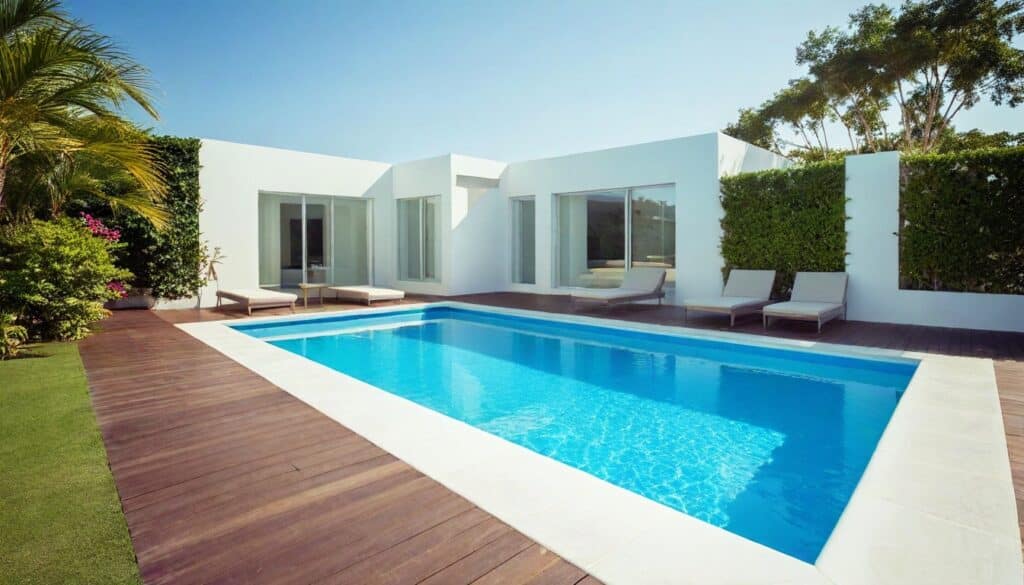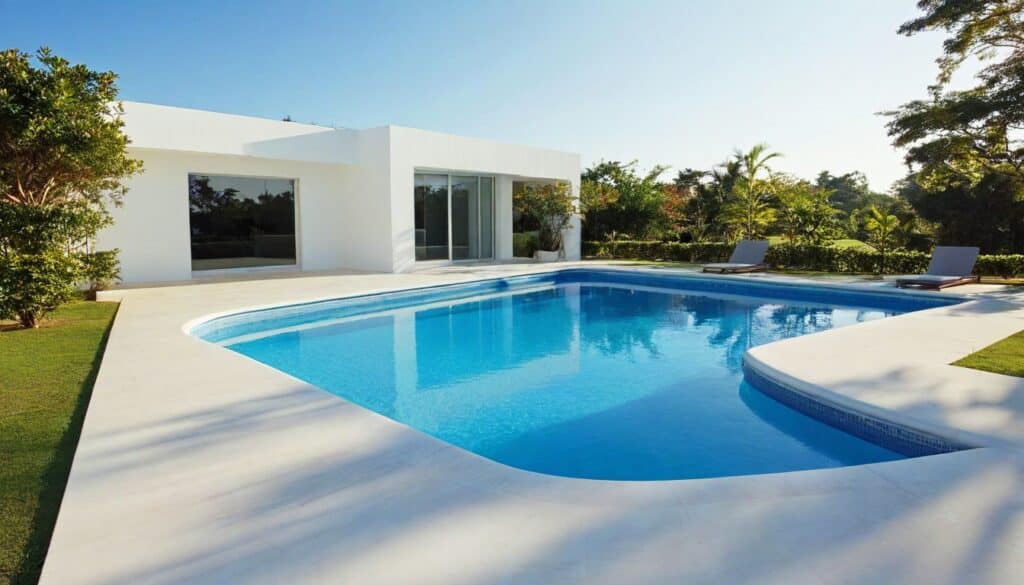Thinking about installing a pool in Melbourne but worried about the unpredictable weather? You’re not alone. While Melbourne’s climate isn’t as tropical as Queensland’s, with the right design and heating choices, a swimming pool can be a valuable and enjoyable addition to any Melbourne home.
In fact, more and more homeowners are turning to expert pool builders in Melbourne to create backyard retreats that suit both lifestyle and climate — extending the swimming season and adding real property value. From clever positioning to modern heating systems, making a pool work in Melbourne is not only possible — it’s smart.
Whether you’re in the leafy east, by the bay, or up on a breezy hilltop suburb, this guide will walk you through everything you need to know to make your pool a true year-round asset.
Understanding Melbourne’s Pool Climate: Key Considerations
Seasonal Variations and Pool Usage Patterns
Melbourne’s climate is famously temperamental — “four seasons in one day” isn’t just a saying, it’s a lived experience. Summers can be hot and dry, with average temperatures around 26–30°C (78–86°F), while winters are cool and often overcast. This seasonal contrast has a direct impact on how often, and when, you’ll use your pool.
In general, the swimming season in Melbourne spans from late November through March, but without heating, usage can be limited to the warmest weeks. For families, this may mean short, spontaneous dips. For serious swimmers or entertainers, extending usability becomes essential — making climate-smart pool design a must.
How Melbourne’s Weather Affects Pool Water Temperature
Even on warm days, Melbourne’s weather can turn quickly — with cold fronts or strong winds reducing perceived temperature and lowering water comfort. On average, an unheated pool in Melbourne only reaches 22–24°C (71–75°F) in peak summer, which can feel brisk for many swimmers.
According to Melbourne’s Bureau of Meteorology, wind chill and limited sun exposure in some suburbs can drastically reduce thermal gain. That’s why modern pool builders in Melbourne are incorporating passive heating principles — like darker surfaces, thermal covers, and heat-retaining designs — into every project.

Is Year-Round Swimming Realistic in Melbourne?
With the right approach, yes — but it takes planning. A year-round pool in Melbourne typically relies on one or more heating systems, combined with a smart layout that shields the pool from shade and wind. Solar heaters, heat pumps, and even gas heaters can extend swimming well into autumn or start earlier in spring.
For example, a solar-heated pool can increase water temperature by 5–8°C during the swimming season, according to Sustainable Energy Authority Victoria. This makes a huge difference for families or fitness enthusiasts who want regular access.
Ultimately, the goal isn’t to fight the climate — it’s to design in harmony with it.
Smart Heating and Design Tips for Melbourne Pools
Choosing the Right Pool Heating System
In Melbourne’s variable climate, choosing the right heating solution can dramatically improve your pool’s usability. Among the most popular options are solar heating systems, electric heat pumps, and gas heaters — each with pros and cons depending on your budget, space, and desired swimming season.
Aligning with the latest pool trends in Melbourne towards sustainability, solar heating is a favourite for eco-conscious homeowners, particularly in the city’s sunnier eastern suburbs. It’s cost-effective over time, using roof-mounted panels to warm water without ongoing fuel expenses. According to EcoSmart Solar, a standard system can increase pool water by 6–10°C on average summer days.
Electric heat pumps are reliable even during cooler periods, but require more upfront investment. Gas heaters, meanwhile, are ideal for those wanting rapid heat-up times — perfect for weekend entertainers or spas.
Orientation, Landscaping, and Design Choices that Optimise Warmth
A well-designed pool doesn’t just look good — it works with the sun, not against it. To capture as much warmth as possible, professional pool builders in Melbourne recommend positioning your pool in a north-facing orientation when possible. This ensures optimal sun exposure throughout the day.
Landscaping also plays a critical role: strategic use of fencing, shrubs, or walls can shield your pool from cold winds while enhancing privacy and aesthetics. Even the colour of your pool surface affects heat retention — darker finishes can absorb and hold more warmth.
Want to go a step further? Consider installing a thermal blanket or automatic pool cover to trap heat overnight and reduce evaporation. These small details significantly extend usability.
Cost vs Comfort: Budgeting for Heating Solutions
While investing in pool heating will influence the average cost of building a pool in Melbourne, it’s often the difference between a pool that gets used and one that doesn’t. Solar systems typically cost between $3,000–$5,000 upfront, with minimal operating costs. Heat pumps range from $4,000–$7,000, and gas systems can be slightly more depending on usage.
The key is to weigh long-term comfort against initial investment. As highlighted by Swimart Australia, combining multiple systems — such as solar with a backup gas heater — can offer year-round flexibility without breaking the bank.
In the end, smart heating isn’t just about temperature — it’s about maximising enjoyment, extending your swimming season, and increasing property value.

Planning for Your Suburb: Tailored Advice by Location
How to Heat a Pool for Year-Round Use in Melbourne’s Eastern Suburbs
Melbourne isn’t just one climate — it’s many microclimates stitched together by geography. Where you live in the city can drastically affect your pool’s performance, exposure, and maintenance needs. That’s why successful pool projects in Melbourne go beyond generic advice — they’re tailored to your suburb.
For example, homes in elevated or coastal areas are often subject to higher wind exposure, while properties in leafy eastern suburbs might have shaded backyards or more tree debris to manage. These factors don’t just influence comfort — they affect heat retention, water cleanliness, and long-term usage.
Curious how your suburb affects your pool? Explore the detailed local insights below:
If you live in leafy suburbs like Camberwell, Balwyn, or Glen Iris, shade and limited winter sun can be challenges. How to Heat a Pool for Year-Round Use in Melbourne’s Eastern Suburbs.
Wind Exposure and Shade: How to Protect Your Pool in Melbourne’s Coastal and Hilltop Suburbs
Coastal winds or hillside breezes can make your pool feel 5°C colder than the thermometer suggests. Discover practical solutions — from wind barriers to cover systems — in our focused article: [Wind Exposure and Shade: How to Protect Your Pool in Melbourne’s Coastal and Hilltop Suburbs]. Coastal winds or hillside breezes can make your pool feel 5°C colder than the thermometer suggests. Discover practical solutions — from wind barriers to cover systems — in our focused article: Wind Exposure and Shade: How to Protect Your Pool in Melbourne’s Coastal and Hilltop Suburbs
Melbourne’s climate may be unpredictable, but your enjoyment of a beautiful, functional pool doesn’t have to be. With smart heating systems, thoughtful design, and suburb-specific planning, a pool in Melbourne can be a year-round investment in lifestyle and property value.
Whether you’re looking to take a refreshing summer dip, extend the swimming season with efficient heating, or create a stunning outdoor entertainment zone — the key is partnering with a skilled pool builder in Melbourne who understands how to work with, not against, the local climate.
Don’t let Melbourne’s changing weather stop you. With the right strategy, your backyard pool can become one of your home’s most-used and most-loved features.
